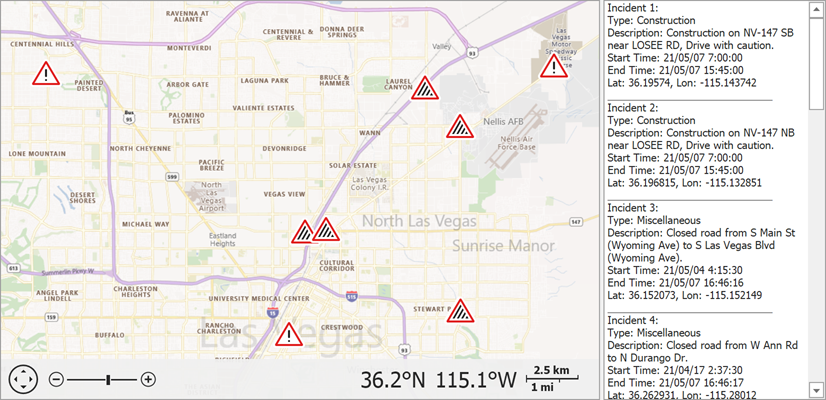BingTrafficIncidentDataProvider.TrafficIncidentCalculated Event
Occurs after the provider has received a list of traffic incidents.
Namespace: DevExpress.XtraMap
Assembly: DevExpress.XtraMap.v24.1.dll
NuGet Package: DevExpress.Win.Map
Declaration
Event Data
The TrafficIncidentCalculated event's data class is BingTrafficIncidentCalculatedEventArgs. The following properties provide information specific to this event:
| Property | Description |
|---|---|
| Cancelled | Gets a value indicating whether an asynchronous operation has been canceled. Inherited from AsyncCompletedEventArgs. |
| Error | Gets a value indicating which error occurred during an asynchronous operation. Inherited from AsyncCompletedEventArgs. |
| RequestResult | Returns results of a request to a web service for traffic incident information. |
| UserState | Gets the unique identifier for the asynchronous task. Inherited from AsyncCompletedEventArgs. |
The event data class exposes the following methods:
| Method | Description |
|---|---|
| RaiseExceptionIfNecessary() | Raises a user-supplied exception if an asynchronous operation failed. Inherited from AsyncCompletedEventArgs. |
Example
How to: Obtain and Display a List of Traffic Incidents
This example obtains a list of incidents in the specified area from the Bing Maps service and displays information about obtained incidents in a MemoEdit control.

Create an InformationLayer object and add it to the MapControl.Layers collection.
Initialize the layer’s DataProvider property with a BingTrafficIncidentDataProvider object.
Specify the provider’s BingKey property.
Call the provider’s RequestTrafficIncidents method to receive a list of incidents.
Handle the
BingTrafficIncidentDataProvider.TrafficIncidentCalculatedevent to access the list of incidents and display incident-related information in a MemoEdit control.
using DevExpress.Map;
using DevExpress.XtraMap;
using System;
using System.Text;
using System.Windows.Forms;
namespace TrafficAndIncidents {
public partial class Form1 : Form {
private void Form1_Load(object sender, EventArgs e) {
// Create a background image layer.
ImageLayer imageLayer = new ImageLayer();
mapControl1.Layers.Add(imageLayer);
BingMapDataProvider provider = new BingMapDataProvider();
imageLayer.DataProvider = provider;
provider.BingKey = "Insert your Bing Key.";
provider.Kind = BingMapKind.RoadLight;
// Create an information layer.
InformationLayer infoLayer = new InformationLayer();
mapControl1.Layers.Add(infoLayer);
// Create a BingTrafficIncidentDataProvider and assign it to the information layer.
BingTrafficIncidentDataProvider trafficIncidentDataProvider = new BingTrafficIncidentDataProvider();
infoLayer.DataProvider = trafficIncidentDataProvider;
trafficIncidentDataProvider.BingKey = "Insert your Bing Key."
BingTrafficIncidentSeverity incidentSeverity = BingTrafficIncidentSeverity.LowImpact | BingTrafficIncidentSeverity.Minor | BingTrafficIncidentSeverity.Moderate | BingTrafficIncidentSeverity.Serious;
BingTrafficIncidentType incidentType = BingTrafficIncidentType.Accident | BingTrafficIncidentType.Construction | BingTrafficIncidentType.Miscellaneous
| BingTrafficIncidentType.Weather;
// Request a list of incidents in the specified area.
trafficIncidentDataProvider.RequestTrafficIncidents(new SearchBoundingBox( -115.338457, 36.268745, -114.988268, 36.1010376),
incidentSeverity,
incidentType);
trafficIncidentDataProvider.TrafficIncidentCalculated += OnTrafficIncidentCalculated;
infoLayer.DataRequestCompleted += OnDataRequestCompleted;
}
private void OnDataRequestCompleted(object sender, RequestCompletedEventArgs e) {
// Call the ZoomToFitLayerItems method to zoom the map so that it displays all the obtained incidents.
mapControl1.ZoomToFitLayerItems();
}
private void OnTrafficIncidentCalculated(object sender, BingTrafficIncidentCalculatedEventArgs e) {
if (e.Cancelled) return;
if (e.RequestResult.ResultCode != RequestResultCode.Success) {
memoEdit1.Text = "Traffic incidents were not found for this area.";
return;
}
StringBuilder resultList = new StringBuilder("");
int resCounter = 1;
foreach (BingTrafficIncidentResult resultInfo in e.RequestResult.IncidentResults) {
resultList.Append(string.Format("Incident {0}: \r\n", resCounter));
resultList.Append(string.Format("Type: {0}\r\n", resultInfo.Type));
resultList.Append(string.Format("Description: {0}\r\n", resultInfo.Description));
resultList.Append(string.Format("Start Time: {0}\r\n", resultInfo.StartTime));
resultList.Append(string.Format("End Time: {0}\r\n", resultInfo.EndTime));
resultList.Append(string.Format("Lat: {0}, Lon: {1}\r\n", resultInfo.Point.Latitude, resultInfo.Point.Longitude));
resultList.Append(string.Format("______________________________\r\n"));
resCounter++;
}
memoEdit1.Text = resultList.ToString();
}
}
}